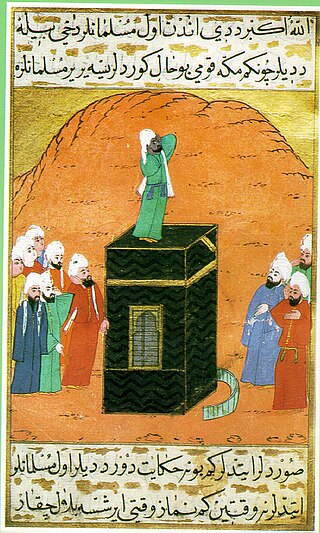The Five Pillars of Islam are fundamental practices in Islam, considered to be obligatory acts of worship for all Muslims. They are summarized in the hadith of Gabriel. The Sunni and Shia agree on the basic details of the performance and practice of these acts, but the Shia do not refer to them by the same name. They are: Muslim creed, prayer, charity to the poor, fasting in the month of Ramadan, and the pilgrimage to Mecca for those who are able.
The athan is the first Islamic call to prayer, usually recited by a muezzin at five times of the day in a mosque, traditionally from a minaret. The adhan is also the first thing recited in the ear of a newborn baby. Its often the first thing recited in a new home.

The muezzin is the person who proclaims the call to the daily prayer (ṣalāt) five times a day at a mosque from the minaret. The muezzin plays an important role in ensuring an accurate prayer schedule for the Muslim community.

The Maghrib prayer is one of the five mandatory salah. If counted from midnight, it is the fourth one.

The Isha prayer is one of the five mandatory salah, and contains 4 cycles (rakah).
The Fajr prayer is the salah offered in the early morning. Consisting of 2 rak'a, it is performed between the break of dawn and sunrise. It is one of two prayers mentioned by name in the Quran. Due to its timing, Islamic belief holds the Fajr prayer to be of great importance. During the Islamic holy month of Ramadan, Muslims begin fasting with the Fajr prayer.

The Zuhr prayer is one of the five daily mandatory Islamic prayers (salah). It is observed after Fajr and before Asr prayers, between the zenith of noon and sunset, and contains four cycles (rakah).

The Asr prayer is one of the five mandatory salah.
A Rak'a is a single iteration of prescribed movements and supplications performed by Muslims as part of the prescribed obligatory prayer known as salah. Each of the five daily prayers observed by Muslims consists of a number of raka'at.
The Farewell Pilgrimage refers to the one Hajj pilgrimage that Muhammad performed in the Islamic year 10 AH, following the Conquest of Mecca. Muslims believe that verse 22:27 of the Quran brought about the intent to perform Hajj in Muhammad that year. When Muhammad announced this intent, approximately 100,000 of his Sahaba gathered in Medina to perform the annual pilgrimage with him. Muhammad performed Hajj al-Qiran.
In Islam, a nafl prayer, or optional prayer, is a type of a non-obligatory prayer. They are believed to give extra reward to the person performing them, similar to sunnah prayers.
A Sunnah prayer is an optional or supererogatory salah that can be performed in addition to the five daily salah, which are compulsory for all Muslims. Sunnah prayer have different characteristics: some are done at the same time as the five daily compulsory prayers, some are done only at certain times, or only for specific occasions ; some have their own name and some are identified by how they are performed. The length of Sunnah prayer also varies.
Holy Du'ā is the mandatory Nizari Isma'ili prayer recited three times a day: Fajr prayer at dawn, Maghrib prayer at sundown and Isha prayer in the evening. Each Holy Du'a consists of 6 rakat, totaling 18 per day, as opposed to the 17 of Sunni and Twelver salat (namaz).
The Khalafiyya Shia were a subsect of the Zaidi branch of Shia Islam.
The Duha prayer is the voluntary Islamic prayer between the obligatory Islamic prayers of Fajr and Dhuhr. The time for this prayer begins when the sun has risen to the height of a spear, which is fifteen or twenty minutes after sunrise until just before the sun passes its zenith. When prayed at the beginning of its time it is called Ishraaq prayer. Salat al Duha is done to forgive sins and as a form of charity. Abu Dharr reports that Muhammad said: "Charity is required from every part of your body daily. Every saying of 'Glory to be to Allah' is a charity. Every saying of 'Praise be to Allah' is charity. Every saying of 'There is no God but Allah' is charity. Every saying of 'Allah is the Greatest' is charity. Ordering the good is charity. Eradicating evil is charity. And what suffices for that are the two raka'at of Duha." This is related by Ahmad, Muslim, and Abu Dawud as well. It is also known in Bengali as Chashter Namaz and in Urdu as Namāz-e-Chāsht. It can be prayed either for four raka'at or until 6 raka'at. If one should pray four raka'at, it should be split into two.
Salaat is a 2010 art film by Kaz Rahman.
Salah, is the principal form of worship in Islam. Facing Mecca, it consists of units called rak'a, during which the Quran is recited, and prayers from the Sunnah are typically said. The number of rak'a varies from prayer to prayer. Minor details of performing salah may differ according to the madhhab of the person performing it.

Salat al-jama‘ah or prayer in congregation (jama'ah) is considered to have more social and spiritual benefit than praying by oneself. When praying in congregation, the people stand in straight parallel rows behind the chosen imam, facing qibla. The imam, who leads the congregation in salat, is usually chosen to be a scholar or the one who has the best knowledge of the Qur'an, preferably someone who has memorised it in its entirety. In the first row behind the Imam, if available, would be another hafiz to correct the Imam in case a mistake is made during the performance of the salat. The prayer is performed as normal, with the congregation following the actions and movements of the imam as he performs the salat.

The signs prayer is one of the Muslim prayers that is optional for Sunni Muslims, but mandatory for Shīʿa Muslims. When solar or lunar eclipses, earthquakes, thunder, or other natural phenomena occur, Muslims may have to pray Ṣalāt al-ʾĀyāt. In Twelver Shia Islam, al-Ayat Prayer consists of two Rakats, and there are five Ruku in each. It is for specific conditions and have been described in detail in resalah of marja's.































